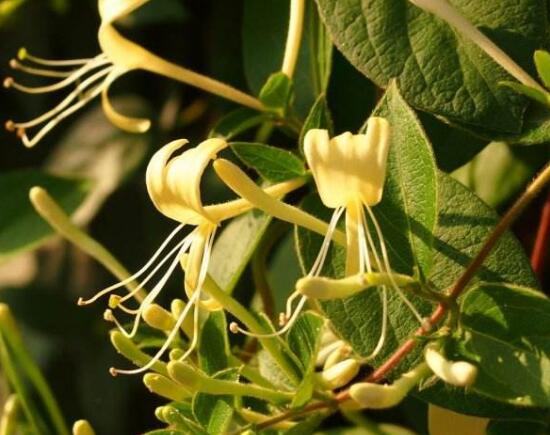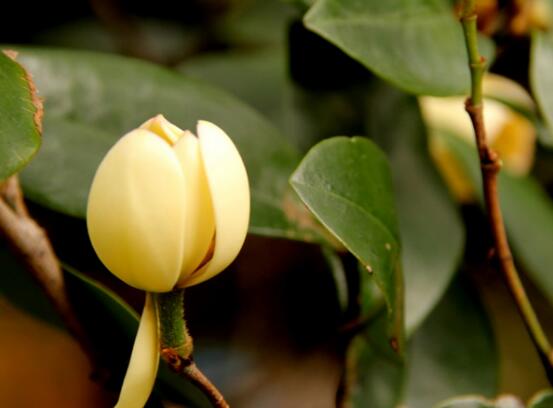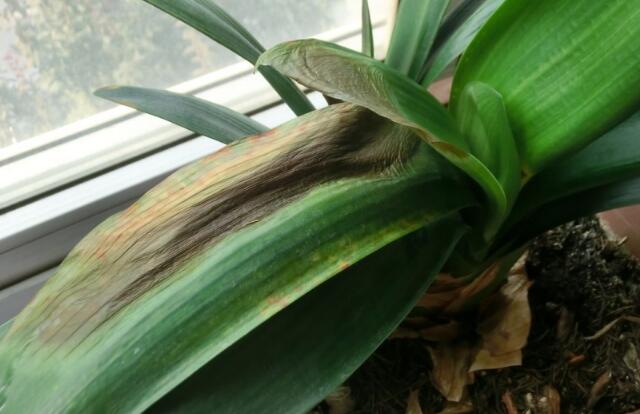What about the yellowing of honeysuckle leaves? the reason for the yellowing of honeysuckle leaves (caused by improper watering)
First, what if the leaves of honeysuckle turn yellow, and cut the withered leaves to prescribe the right medicine

Honeysuckle is a kind of flower plant that is easy to raise. We talked about how to raise honeysuckle and the efficacy and function of honeysuckle. Now let's take a look at how the leaves of honeysuckle turn yellow. There are many reasons for the yellowing of honeysuckle leaves, the most common is overwatering, at this time the leaves yellowing is water yellow, we should cut off these withered leaves and wait for the soil to dry.
Second, the reason for the yellowing of honeysuckle leaves.
1. Watering
Honeysuckle likes the moist growth environment and has high requirements for air humidity. Underwatering can cause root damage or when the air is too dry, it can cause honeysuckle leaves to turn yellow. On the contrary, if too much watering, stagnant water in the basin and poor drainage, the roots of honeysuckle will rot without oxygen, yellow leaves will appear, and even die.
Solution: what if the honeysuckle leaves turn yellow in this situation? First of all, check the soil in the flowerpot to see if there is too much water, because the stagnant water for a long time will cause poor breathing in the roots and lead to the loss of yellow leaves. Stop watering at this time. If it is a potted plant, put it in a ventilated place in time and wait for the soil to dry.
2. Fertilization
If the honeysuckle leaves are yellow caused by fertilization, it is generally due to excessive fertilization at one time, resulting in the root burns of honeysuckle and yellow leaves. Because the growth of honeysuckle actually does not need big fertilizer, fertilization should be thin fertilizer, these are the reasons for the yellowing of honeysuckle leaves.
Solution: do not use non-mature fertilizer, do not fertilize too much at a time, some flower lovers like to use nutritious soil to grow flowers directly, it is best to add a little ordinary garden soil.
3. Lack of fertilizer
It is caused by insufficient fertilizer, low fertilization concentration and long interval of fertilization; it is characterized by yellow young leaves and tender stems, and if it is not fertilized in time after seeing this phenomenon, it will cause yellow leaves and even death of the whole plant. For flowers that lack fertilizer, do not apply a large amount of thick fertilizer at one time, so as not to cause root burning.
3. Diseases and insect pests
If honeysuckle encounters diseases and insect pests, there will also be yellowing of leaves, such as leaf spot, anthrax and so on. Rotten roots will also lead to yellowing of leaves, even more harmful, which is also the common reason for the yellowing of honeysuckle leaves.
Solution: the general honeysuckle appeared diseases and insect pests, affecting the leaves will be a gradual process. In the early stage of the onset of diseases and insect pests, if they can be found in time, measures can be taken. According to the symptoms of honeysuckle, to judge which kind of diseases and insect pests honeysuckle encountered, and choose the corresponding treatment measures, spraying pesticides or artificial control, will alleviate the yellowing of orchid leaves.
Honeysuckle is a kind of flower plant that is easy to raise, but if the breeding method is used, the leaves will turn yellow and withered and other reasons. The above are the reasons for the yellowing of honeysuckle leaves and how to do all the answers. I hope I can help you.
What about Anthurium andraeanum leaves yellowing? what about Anthurium andraeanum leaves yellowing?
When many plants are cultured, there will be a lot of problems in breeding, such as yellowing leaves, diseases and insect pests and so on, which will affect the normal growth of plants. Some friends breed Anthurium andraeanum at home, but the leaves of Anthurium andraeanum are yellow. What should I do? Let's take a look at some of the more common ways to deal with it. The reason for the yellowing of plant leaves. First, old leaves and new leaves appear yellow at the same time, mainly because of the long-term lack of light. Solution: appropriate, appropriate increase in light. Second, the second situation is that the old leaves turn yellow. This will happen if there is a long-term lack of water or if the water is not watered thoroughly. Solution: water the flowers thoroughly. Third, if the new leaves turn yellow, but the old leaves are normal, it means that the amount of watering is too large, or the lack of fertilizer. Solution: control watering, or topdressing. First of all, the treatment method is to cut off the yellowing leaves, put them in a cool place, wait for the water to dry, and then water it, do not rush to fertilize. There may be two situations, one is that the air humidity is too low, that is, too dry, and the other is the lack of trace mineral elements. Control the temperature and humidity, bask in the sun in the morning and evening, and apply fertilizer properly. Anthurium andraeanum leaves appear yellowing, dry, rotten symptoms, is caused by bacteria, to remove bacteria can be sprayed with 0.3% solution of garlic juice, 0.2% solution of vinegar or carbendazim, chlorothalonil and other fungicides. Anthurium andraeanum should be managed in a semi-overcast, humid and warm environment, with the best temperature between 20-25 ℃ and no higher than 33 ℃, otherwise it is prone to uncomfortable symptoms; the air humidity must be between 75-90%, and the leaves below 50% are prone to scorch edge drying. Fertilization should not be too thick, should be fully water-soluble fertilizer irrigated basin soil, can not apply general chemical fertilizer, because Anthurium can not be absorbed, will produce fertilizer damage. The maintenance environment should be semi-yin, not full yin or full yang. Anthurium is particularly fond of light, so it is necessary to often turn the growth direction and keep the plant shape beautiful. The water quality must be clean or fertile, but it should not be directly irrigated with tap water, because harmful substances such as chlorine in tap water can cause poor growth or even death of Anthurium andraeanum, and water should be dried for about 2 days before watering. It is best to put it close to Anthurium andraeanum, so that there is no temperature difference between the water temperature and the temperature of the basin soil, and it will not hurt the capillaries of Anthurium andraeanum. Conclusion: the above is the introduction of the relevant information about the yellowing of Anthurium andraeanum leaves. Some of the information may not be correct. Please forgive me. When carrying out plant culture, we must be careful, do not ignore the planting conditions of plants, this will affect the growth of plants. More Information | what does White Rose mean | Plant Anti-computer radiation | Geranium | Rhododendron Culture methods and precautions | Lavender florescence | Indoor foliage plants | Parthenocissus | Lilium foliage | efficacy and function of mint | Culture method of mimosa | | how to raise succulent plants | Osmanthus | gynostemma pentaphyllum | hand-made roses | efficacy and function of honeysuckle | Kumquat |
What about the yellow leaves of Anthurium andraeanum? picture appreciation of Anthurium andraeanum
When many plants are cultured, there will be a lot of problems in breeding, such as yellowing leaves, diseases and insect pests and so on, which will affect the normal growth of plants. Some friends breed Anthurium andraeanum at home, but the leaves of Anthurium andraeanum are yellow. What should I do? Let's take a look at some of the more common ways to deal with it. The reason for the yellowing of plant leaves. First, old leaves and new leaves appear yellow at the same time, mainly because of the long-term lack of light. Solution: appropriate, appropriate increase in light. Second, the second situation is that the old leaves turn yellow. This will happen if there is a long-term lack of water or if the water is not watered thoroughly. Solution: water the flowers thoroughly. Third, if the new leaves turn yellow, but the old leaves are normal, it means that the amount of watering is too large, or the lack of fertilizer. Solution: control watering, or topdressing. First of all, the treatment method is to cut off the yellowing leaves, put them in a cool place, wait for the water to dry, and then water it, do not rush to fertilize. There may be two situations, one is that the air humidity is too low, that is, too dry, and the other is the lack of trace mineral elements. Control the temperature and humidity, bask in the sun in the morning and evening, and apply fertilizer properly. Anthurium andraeanum leaves appear yellowing, dry, rotten symptoms, is caused by bacteria, to remove bacteria can be sprayed with 0.3% solution of garlic juice, 0.2% solution of vinegar or carbendazim, chlorothalonil and other fungicides. Anthurium andraeanum should be managed in a semi-overcast, humid and warm environment, with the best temperature between 20-25 ℃ and no higher than 33 ℃, otherwise it is prone to uncomfortable symptoms; the air humidity must be between 75-90%, and the leaves below 50% are prone to scorch edge drying. Fertilization should not be too thick, should be fully water-soluble fertilizer irrigated basin soil, can not apply general chemical fertilizer, because Anthurium can not be absorbed, will produce fertilizer damage. The maintenance environment should be semi-yin, not full yin or full yang. Anthurium is particularly fond of light, so it is necessary to often turn the growth direction and keep the plant shape beautiful. The water quality must be clean or fertile, but it should not be directly irrigated with tap water, because harmful substances such as chlorine in tap water can cause poor growth or even death of Anthurium andraeanum, and water should be dried for about 2 days before watering. It is best to put it close to Anthurium andraeanum, so that there is no temperature difference between the water temperature and the temperature of the basin soil, and it will not hurt the capillaries of Anthurium andraeanum. Conclusion: the above is the introduction of the relevant information about the yellowing of Anthurium andraeanum leaves. Some of the information may not be correct. Please forgive me. When carrying out plant culture, we must be careful, do not ignore the planting conditions of plants, this will affect the growth of plants. More Information | what does White Rose mean | Plant Anti-computer radiation | Geranium | Rhododendron Culture methods and precautions | Lavender florescence | Indoor foliage plants | Parthenocissus | Lilium foliage | efficacy and function of mint | Culture method of mimosa | | how to raise succulent plants | Osmanthus | gynostemma pentaphyllum | hand-made roses | efficacy and function of honeysuckle | Kumquat |
- Prev

Is the Michelia flower poisonous? why is it bad to grow Michelia flowers at home / the smell of non-toxic flowers is too strong?
The beauty of Michelia flowers is recognized by the majority of flower friends, and its shape, color and fragrance are unique, so many people keep it indoors. But it is its beauty that reminds some people of a sentence: the more beautiful the plant is, the more poisonous the plant is. Is the Michelia flower poisonous? In life
- Next

What if the leaves of the orchid turn yellow? seven moves to make the leaves green / water and fertilizer for a year is the key.
Thick green leaves, broad and open to both sides, neat and good-looking, this is the gentleman orchid. Keeping it at home is definitely a kind of visual enjoyment. However, in the process of breeding, due to various reasons, the leaves of Cymbidium will appear yellowing symptoms, then what about the yellowing of the leaves?
Related
- Fuxing push coffee new agricultural production and marketing class: lack of small-scale processing plants
- Jujube rice field leisure farm deep ploughing Yilan for five years to create a space for organic food and play
- Nongyu Farm-A trial of organic papaya for brave women with advanced technology
- Four points for attention in the prevention and control of diseases and insect pests of edible fungi
- How to add nutrient solution to Edible Fungi
- Is there any good way to control edible fungus mites?
- Open Inoculation Technology of Edible Fungi
- Is there any clever way to use fertilizer for edible fungus in winter?
- What agents are used to kill the pathogens of edible fungi in the mushroom shed?
- Rapid drying of Edible Fungi

